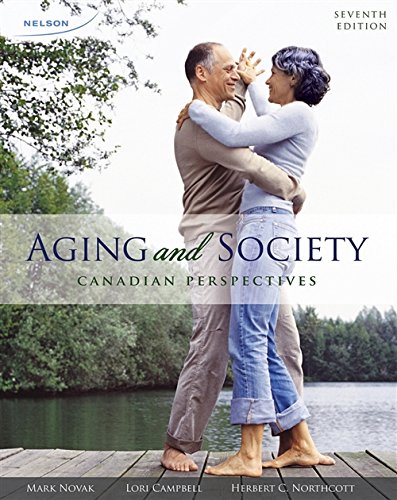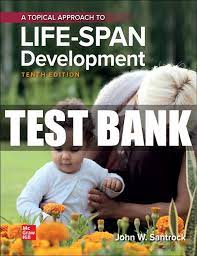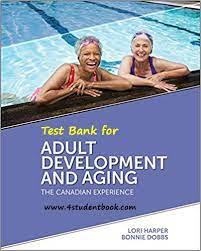Description
Test Bank For Aging And Society Canadian Perspectives 7th Edition By by Lori Campbell, Herbert C
CHAPTER 2: THEORIES AND METHODS
MULTIPLE CHOICE
1.In 1980, the Gerontological Society surveyed 111 scholars to establish a core program for the field of gerontology. Though the experts disagreed as to the content and boundaries of the field, which of the following items did the scholars collectively believe?
|
a. |
Three areas of study should form the core of the curriculum. |
|
b. |
The socioeconomic-environmental aspects of aging should be the main focus of courses at the introductory level. |
|
c. |
A consensus on the definition must be reached before gerontology can grow as a discipline. |
|
d. |
A comprehensive program would be difficult to construct because of problems in deciding what aspects of aging are the most important. |
ANS: A REF: 22 BLM: REM
2.Which area of study in gerontology examines the physiological and health changes that occur as people age?
|
a. |
physio-environmental studies |
|
b. |
cohort medical studies |
|
c. |
psycho-physiological studies |
|
d. |
biomedical studies |
ANS: D REF: 22 BLM: REM
3.Which of the following would be an example of a psychosocial study in gerontology?
|
a. |
formal social supports |
|
b. |
causes of dementia |
|
c. |
relationships between individuals and groups |
|
d. |
effects of healthcare systems |
ANS: C REF: 22 BLM: HO
4.George is conducting research about the effects of aging on the educational structure as well as the effects of social structures on older people. Which area of gerontology is he studying?
|
a. |
psychosocial studies |
|
b. |
socio-individual studies |
|
c. |
multi-stage development social studies |
|
d. |
socioeconomic-environmental studies |
ANS: D REF: 22 BLM: HO
5.Which areas of research are combined in the field of social gerontology?
|
a. |
socioeconomic-environmental, psychosocial, and practice-related research |
|
b. |
biomedical and socioeconomic-environmental research |
|
c. |
psychosocial, social policy, and social sciences research |
|
d. |
biological, psychological, and health sciences research |
ANS: A REF: 22 BLM: REM
6.Which field looks at aging from the points of view of both the individual and the social system?
|
a. |
geriatrics |
|
b. |
psychosocial studies |
|
c. |
social gerontology |
|
d. |
didactic-senescence |
ANS:CREF:22BLM: REM
7.Why do social gerontologists examine the biological and physical changes that occur in old age?
|
a. |
to adapt the research obtained to their field of study |
|
b. |
to study the relationship between biological aging and personal relationships |
|
c. |
to see how the changes affect the individual or society as a whole |
|
d. |
to establish a unified basis for the studies of biomedical, psycho-social, and socioeconomic-environmental studies |
ANS: C REF: 23 BLM: HO
8.What do social gerontologists use to guide their research and interpret the results of studies?
|
a. |
statistics and demographics |
|
b. |
test sampling |
|
c. |
theories |
|
d. |
focus groups |
ANS:CREF:23BLM: REM
9.How is a theory deemed to be a valuable tool for a researcher?
|
a. |
It gives concrete and final answers to questions. |
|
b. |
It provides practical information for the development of social programs and interventions. |
|
c. |
It provides essential trivial information about aging. |
|
d. |
It explains all the facts about aging. |
ANS: B REF: 23 BLM: HO
10.According to the text, how does a researcher select a theory to use in order to explain a set of research findings?
|
a. |
according to the researcher’s sense of how the world works |
|
b. |
according to the original hypotheses of the study |
|
c. |
according to recent academic trends |
|
d. |
according to journal preferences and peer reviews |
ANS: A REF: 23 BLM: REM
11.Kayla is examining a theory that focuses on individuals and their interactions with one another, such as a brief confrontation at a parents’ school meeting. Which of the following is Kayla studying?
|
a. |
micro-level |
|
b. |
interpersonal |
|
c. |
psychological |
|
d. |
organic |
ANS: A REF: 23 BLM: HO
12.Which theories focus on social structure, social processes and problems, and their interrelationship?
|
a. |
macro-level theories |
|
b. |
socio-political interactive theories |
|
c. |
global perspectives |
|
d. |
micro-level theories |
ANS: A REF: 23-24 BLM: REM
13.Which of the following would be an example of a phenomenon explained by micro-level theories?
|
a. |
the effect of positive attitudes on older people |
|
b. |
the effect of industrialization on older peoples’ social status |
|
c. |
changes in memory with age |
|
d. |
how gender and income affect older people’s well-being |
ANS: C REF: 23-24 BLM: HO
14.Which of the following is a criticism of micro-level theories?
|
a. |
They oversimplify social life. |
|
b. |
They minimize the individual’s ability to act. |
|
c. |
They emphasize what people do rather than the economic and social conditions that cause them to act as they do. |
|
d. |
They support a definition of old age as a time of decline. |
ANS:CREF:24BLM: HO
15.Which of the following is a criticism of the theories that examine aging in terms of the social structures that influence behaviour?
|
a. |
that they are not well-supported by research |
|
b. |
that they underestimate people’s ability to overcome the limits of social structures |
|
c. |
that they focus too much on outcomes, and not enough on processes |
|
d. |
that they focus too much on perceptions, and not enough on actions |
ANS: B REF: 24 BLM: HO
16.Which of the following methods assists social gerontologists to disentangle the effects of history,
biology, and the social life on the aging person?
|
a. |
theory |
|
b. |
concept |
|
c. |
evaluation |
|
d. |
model |
ANS: A REF: 23-24 BLM: REM
17.Which aspect of social life does the interpretive perspective mainly focus on?
|
a. |
micro-level |
|
b. |
reorganization |
|
c. |
problems |
|
d. |
functions |
ANS: A REF: 24 BLM: HO
18. Which perspective looks at how people define situations, create social order, and relate to one another?
|
a. |
normative perspective |
|
b. |
interpretive perspective |
|
c. |
social perspective |
|
d. |
ethnomethodology |
ANS:BREF:24BLM: REM
19.Which perspective has historically been used the least by social gerontologists and is now making a resurgence over the last few decades?
|
a. |
normative perspective |
|
b. |
psycho-social perspective |
|
c. |
associative perspective |
|
d. |
interpretive perspective |
ANS: D REF: 24 BLM: REM
20.Which type of theory exemplifies the interpretive perspective?
|
a. |
social pathophysiology |
|
b. |
ethnocentrism |
|
c. |
symbolic interactionist |
|
d. |
disengagement |
ANS: C REF: 24 BLM: HO
21.Weber developed the social phenomenological theory. What does Weber say the researcher needs to do in order to understand a social phenomenon?
|
a. |
develop an unbiased description of the phenomena |
|
b. |
understand the meaning that people in the situation attach to the events and their actions |
|
c. |
develop a theory to clearly specify the relationships between people and events |
|
d. |
examine the social structures that enable the phenomenon to occur |
ANS: B REF: 25 BLM: REM
22.The Elks Lodge is a Canadian club that has its foundations in social order and organization. The club’s first Canadian female Exalted Ruler, Debby Ray, follows which of the following concepts in which the individual is the originator of social order and organization?
|
a. |
the interpretive perspective |
|
b. |
conflict theory |
|
c. |
subculture methodology |
|
d. |
face-to-face interactions |
ANS: A REF: 25 BLM: HO
23.Which of the following is a problem with the interpretive perspective?
|
a. |
It suggests that social life does not have quantifiable measures. |
|
b. |
It talks of social order and organization, without considering their source. |
|
c. |
It places subjective interpretations on objective phenomena. |
|
d. |
It does not focus enough on macro-level social phenomena. |
ANS: D REF: 25-26 BLM: HO
24.Which of the following terms describes the theories within the interpretive perspective?
|
a. |
interpretation constructionism |
|
b. |
situational constructionism |
|
c. |
social constructionism |
|
d. |
interactional constructionism |
ANS:CREF:24BLM: REM
25.What are the basic units at work in the social system as described by functionalist theories?
|
a. |
social institutions |
|
b. |
families |
|
c. |
individuals |
|
d. |
ethnic groups and cohorts |
ANS:AREF:26BLM: HO
26.According to structural functionalism, social institutions adjust to one another as the system responds to internal and external pressures to maintain which of the following?
|
a. |
social evolution |
|
b. |
dynamic equilibrium |
|
c. |
static balance |
|
d. |
homeostasis |
ANS: B REF: 26 BLM: REM
27.Structural functionalism sometimes draws an analogy between which of the following?
|
a. |
group interactions and the postal system |
|
b. |
an individual and a social institution |
|
c. |
society and a living organism |
|
d. |
macro- and micro-level action |
ANS: C REF: 26 BLM: HO
28.Which of the following is an assumption made by structural functionalism?
|
a. |
Society changes and evolves in a negative direction more often than a positive direction. |
|
b. |
Functionalism draws connections only between micro-social structures and individuals’ actions. |
|
c. |
People conform to norms because of a belief in a society’s underlying value system. |
|
d. |
Social problems are natural responses, and should be allowed to resolve themselves. |
ANS: C REF: 26 BLM: HO
29.How are social problems described in structural functionalism?
|
a. |
as internal pressures for change |
|
b. |
as dysfunctions that should be corrected by planning |
|
c. |
as conflicts between social institutions |
|
d. |
as the initial reaction to social change and evolution |
ANS: B REF: 26 BLM: HO
30.Which perspective is used most often by gerontologists?
|
a. |
interactive perspective |
|
b. |
age-stratification perspective |
|
c. |
functionalist perspective |
|
d. |
conflict perspective |
ANS:CREF:26BLM: REM





Be the first to review “Test Bank For Aging And Society Canadian Perspectives 7th Edition By by Lori Campbell, Herbert C”